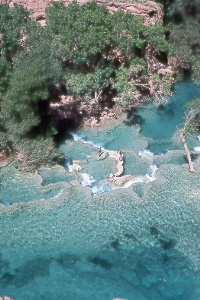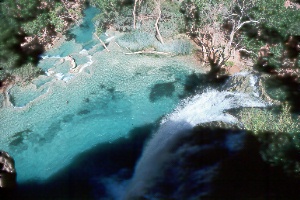

Havasu Falls and its travertine pools below
The towering cliffs of Havasu Canyon enclose a land of blue-green waters, breathtaking waterfalls, and lush vegetation. Havasu Creek rushes through the canyon past the village of Supai before beginning its wild cascade down to the Colorado River. The canyon and its creek, about 35 air miles northwest of Grand Canyon Village, belong to the Havasupai. (Havasu means "blue water," and pai means "people.")
Getting There
The tribe wisely decided against allowing road construction
in the canyon, so most residents and tourists enter by mule, horse, or on foot.
Helicopters provide another option, though the noisy machines seem out of place
here.
The eight-mile trail from Hualapai Hilltop to Supai
is the usual way in. From Seligman on I-40, take AZ 66 northwest for 28 miles (to
between Mileposts 110 and 111), then turn right and go 63 miles on paved Indian
Route 18 to Hualapai Hilltop. If coming from the west, take AZ 66 northeast out
of Kingman for 60 miles, then turn left and drive the 63 miles. Stock up with supplies
before leaving AZ 66, as no gas, water, or stores are available after the turnoff.
The road to Hualapai Hilltop climbs into forests of ponderosa pine that give way
to pinyon and juniper, then desert grasslands close to the rim. Parking areas and
stables mark road's end. Maps show dirt-road shortcuts to Hualapai Hilltop, but
they suffer from poor signing and rough surfaces.
Permits and Fees
You must have reservations, whether staying
in the lodge or camping. Try to make them far ahead, especially for holidays, weekends,
March–June, and Sept.–Nov.; you can use a Visa or Master Card. When
you arrive at Supai, stop to register and pay the $20 entrance fee. The tribe asks
you to leave pets, alcohol, and firearms at home.
If you're
staying at the lodge (see below), make room and horse reservations through the staff
there. Campers make reservations with Havasupai Tourist Enterprise (P.O. Box 160,
Supai, AZ 86435, 928/448-2121 or 928/448-2141,
www.havasupaitribe.com) and pay $10
per person per night. To preserve the canyon floor, no fires or charcoal are allowed,
so bring a stove if you plan to cook. Camping outside the established campground
is prohibited.
Hiking In
From Hualapai Hilltop (elev. 5,200 feet), the trail descends
at a moderate grade into Hualapai Canyon for the first 1.5 miles, then levels off
slightly for the remaining 6.5 miles to Supai village (elev. 3,200 feet). About
1.5 miles before the village, the trail joins the sparkling waters of Havasu Canyon.
Try to get an early start from Hualapai Hilltop, especially in the warmer months—you'll
wish to avoid the heat of the day in summer when temperatures soar past 100ºF!
Take a couple quarts of drinking water. Good hiking boots help on the rough, rocky
stretches of trail. You'll get the most out of a visit with at least two nights
in the canyon. Day hikes from the rim to the waterfalls aren't practical—the
distance and climb would be too much for even strong hikers.
Riding In
If you'd rather ride than walk, local families will take
you and your gear on horses or mules from the parking lot at Hualapai Hilltop to
Supai ($70 one-way or $120 roundtrip) or all the way to the campground ($75 each
way), 2.75 miles farther. One animal can carry about four packs (duffel bags are
best) not exceeding 130 pounds total. A sightseeing ride from Supai to the falls
and back can be arranged with the lodge. You should make reservations a couple of
weeks in advance and pay a 50% deposit. Campers make arrangements through Havasupai
Tourist Enterprise, lodge guests through the lodge. Also call two weeks before arrival
to make sure your animal is available. Visitors may bring their own horses if they
take along feed and pay a $20 trail fee.
The Waterfalls
Major cascades plunge over cliffs of the Redwall Limestone
in a distance of just two miles. A massive flood in August 2008 destroyed Navajo
Falls, leaving two new ones in its place, 1 and 1.25 miles below the village. The
name commemorates a 19th-century Havasupai tribal chief kidnapped by
Navajo as an infant. Not until he grew to manhood did he learn of his true origin
and return to the Havasupai.
A bit farther, spectacular
Havasu Falls drops 100 feet into a beautiful turquoise-colored pool rimmed by
travertine deposits. Clear, inviting waters make this a perfect spot for swimming
or picnicking.
Awe-inspiring Mooney Falls plummets
196 feet into a colorful pool one mile beyond Havasu Falls. The Havasupai named
this most sacred of waterfalls Mother of the Waters. The present name is that of
a prospector who died here in 1880. When assistants lowered Daniel Mooney down the
cliffs next to the falls, the rope jammed and Mooney hung helpless as the rope frayed
and broke. He fell to his death on the rocks below, but 10 months passed before
his companions could make their way down to reach and bury the travertine-encrusted
body. A rough trail descends beside the falls along the same route hacked through
the travertine by miners in those months after Mooney's death. You'll pass through
two tunnels and then ease down with the aid of chains and iron stakes. At the bottom—as
soon as your knees stop shaking—you can enjoy a picnic or swim in the large
pool. Miners extracting silver, lead, zinc, and vanadium drilled the holes that
you see high on the canyon walls.
Beaver Falls, two
miles downstream from Mooney, makes a good day-hike from the campground or Supai.
You'll pass countless inviting travertine pools and small cascades, of which Beaver
Falls is the largest. The trail, rough in places, crosses the creek three times,
climbs high up a cliff, then descends and crosses a fourth time below Beaver Falls.
The trail continues downstream along Havasu Creek four more miles to the Colorado
River. Travel fast and light if going to the river, as camping is prohibited below
Mooney Falls. Photographing the falls can be a challenge; the best time to snap
them in full sunlight is in May, June, and July.
|
|
|
Accommodations, Food, and Services
Havasupai Lodge (P.O. Box 159, Supai,
AZ 86435, 928/448-2111, www.havasupaitribe.com,
$75 s, $80 d, $8 each additional person) in Supai village offers non-smoking rooms
with air-conditioning, two double beds, and private bath. The spartan rooms lack
phones or TVs, but you probably won't miss them. Obtain the required reservations
in advance; six weeks is recommended—six months at the most popular times.
The nearby cafe serves breakfast, lunch, and dinner daily, though it closes
about 5 p.m. in winter. Try the Indian taco—red beans, beef, cheese, onion,
and lettuce on fry bread. Ice cream prices are high, though not so bad when you
consider what it takes to bring the frozen dessert to such a remote area. A store
across the street, open daily, sells meat, groceries, and cold drinks. Bring cash
for the cafe and store.
Send your postcard home via pack train—with
a postmark to prove it! The post office next to the store is open weekdays.
A health clinic in Supai provides emergency medical care.
Havasu Campground
Most visitors prefer to camp, listening to the sounds
of the canyon and enjoying the brilliant display of stars in the nighttime sky.
Havasu Campground begins a quarter mile below Havasu Falls (or 10.75 miles from
Hualapai Hilltop) and provides drinking water from a faucet, picnic tables, and
pit toilets. Most people don't realize that the campground extends three-quarters
of a mile along Havasu Creek to the brink of Mooney Falls. You'll enjoy more solitude
if you walk to the far end. Theft is a problem in the campground, so don't leave
valuables in your tent or lying around.